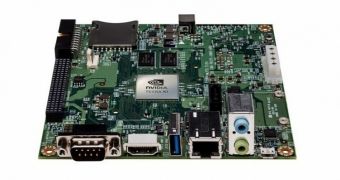CUDA is NVIDIA's parallel computing platform and programming model, which allows GPU cores to be used for mathematical computations and other general purpose tasks instead of video rendering. The newest mobile system-on-chip from the company supports it.
CUDA has been mentioned often enough in the spec sheets of desktop add-in graphics cards and laptop discrete GPUs. However, the technology also shines in supercomputers.
The Tegra Jetson K1 probably won't make a huge impact there (despite how NVIDIA has been supplying it to HPC universities and researchers).
On the mobile front, though, it should enable the creation of many high-end tablets, 2-in-1 devices, and more. Not smartphones though, since Jetson is not so much a chip as it is a mini supercomputing module (it measures 5 x 5 inches / 127 mm).
In fact, people who like to tinker with printed circuit boards and come up with their own devices (like toys or drones) should draw much benefit from the Tegra K1 as well. That's what NVIDIA said anyway.
At the heart of the Tegra K1 lies a quad-core ARM processor, four Cortex-A15 cores to be specific. There's a fifth core too, a low-power one that will take over when nothing strenuous is being processed.
So it's a Tegra 4-PLUS-1 setup, though the clocks are conspicuously absent. Presumably, the core frequencies can be set by product designers based on need and cooling.
The Kepler GPU is more important anyway, with its 192 CUDA cores, which is the same number as on the GeForce GTX 550.
Basically, if product developers manage to fit enough RAM in their gadgets, we may see mobile devices with graphics on par with mid-range add-in boards.
NVIDIA did say, as far back as last year, that it would enable tablets with console-level graphics, and now it's owning up to the promise. The Shield 2 handheld gaming console will probably be the same.
Besides the ARM cores and Kepler graphics, the Jetson Tegra K1 board has 2 GB RAM (64-bit width), 16 GB of eMMC memory, Gigabit Ethernet (Realtek RL8111GS chipset), USB 2.0 (one port), USB 3.0 (again, one port, or rather header) SATA support (for one HDDs, SSD or hybrid drive), RS232 serial connection, ALC5639 Realtek audio (with microphone and line out jack), plus SPI 4NByte boot flash.
In addition to mobile devices, gadgets and robots, the NVIDIA Tegra K1 Development Kit will be used in self-driving cars (Audi is already doing this). NVIDIA is releasing the VisionWorks Computer Vision Toolkit (will help sync the data from the cameras set around the vehicle, with the programmable cores, to spot potential hazards).
The SDK is accompanied, or will be, by apps for robotics, advanced driver assistance systems (ADAS), computational photography, human-machine interaction (HMI), and augmented reality (AR). All for the price of $192 / €138.

 14 DAY TRIAL //
14 DAY TRIAL //